사진으로 본 영아, 타들러아, 학령기전유아,학령기아, 사춘기아 기본 심폐 소생술 처치법 Cardiopulmonary resuscitation for infants, toddlers, preschool children, school children or adolescents in the photos
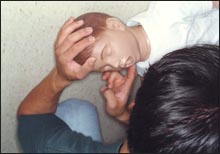
▴ 사진 1-186. ①
처치자의 귀를 환아의 입이나 콧구멍에 바짝 갖다 대고 환아가 숨을 쉬고 있는지 숨소라를 들어본다. Copyright ⓒ 2011 John Sangwon Lee, MD., FAAP
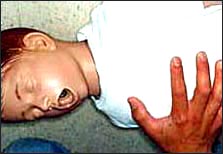
▴ 사진 1-187. ②
앞가슴이나 복부가 숨 쉬는 대로 올라갔다 내려갔다 움직이는지 관찰하든지 환아의 앞가슴 위에 처치자의 손을 올려놓고 숨 쉬는지 알아본다.Copyright ⓒ 2011 John Sangwon Lee, MD., FAAP
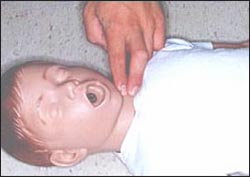
▴ 사진 1-188. ③
경동맥애서 맥박을 짚어본다
1세 이하면 영아의 주관절 앞 부위에 있는 상완동맥(④ 참조)이나 고관절 앞 부위 서혜부(⑤ 참조)에 있는 대퇴동맥에서 맥이 뛰는지 알아보든지, 1세 이상 된 환아면 목에 있는 경동맥 맥박을 짚어 심장이 뛰는지 알아보는 것이 보통이다.
또는 가슴에서 심장이 뛰는지 알아 볼 수도 있다. 이렇게 심장이 뛰는지 알아보는 데 1~2초 이상 더 걸려서는 안 된다. 평소에 맥박을 짚는 법을 배운다. Copyright ⓒ 2011 John Sangwon Lee, MD., FAAP
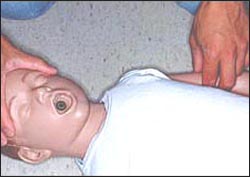
▴ 사진 1-189. ④
왼 쪽 상완동맥에 맥박을 재고 있다.
1~2초 내에 목이나 팔꿈치 앞부위나 서혜부에서 맥박이 뛰는지 또는 가슴에서 심장이 뛰는지 알아본다. Copyright ⓒ 2011 John Sangwon Lee, MD., FAAP
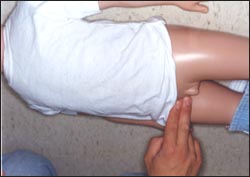
▴ 사진 1-190. ⑤
대퇴동맥에서 맥박을 재고 있다
1~2초 내에 목이나 팔이나 서혜부에서 맥이 뛰는지 또는 가슴에서 심장이 뛰는지 알아본다.
Copyright ⓒ 2011 John Sangwon Lee, MD., FAAP
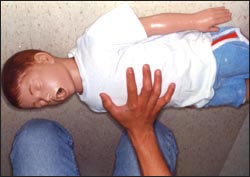
▴ 사진 1-191. ⑥
또 다시, 가슴에서 심장이 뛰는지 숨을 쉬는지 알아본다.
또는 목이나 팔이나 서혜부에서 맥박이 뛰는지 안 뛰는지 알아본다. Copyright ⓒ 2011 John Sangwon Lee, MD., FAAP

▴ 사진 1-192. ⑦
기도를 열러 통기가 잘 되도록 기도를 확보하고 숨을 잘 쉬도록 한다.
처치자의 한쪽 손을 환아의 이마에 올려놓고 환아의 머리를 뒤로 살짝 젖히고 얼굴과 머리를 옆으로 살짝 젖힌 다음 다른 손으로 턱과 얼굴을 살짝 추켜올린다. Copyright ⓒ 2011 John Sangwon Lee, MD., FAAP
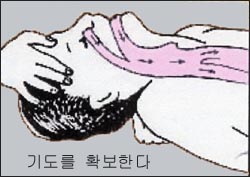
▴ 사진 1-193. ⑧
환아의 목을 뒤로 살짝 젖힌다. 이렇게 처치하는 목적은 사진과 같이 인공호흡을 할 때 공기가 기도 속으로 잘 들어가고 나오도록 하기 위해서이다. Copyright ⓒ 2011 John Sangwon Lee, MD., FAAP
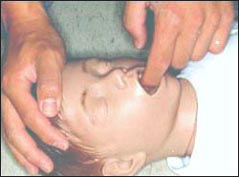
▴ 사진 1-194. ⑨
입안이나 비강 속에 분비물이 있으면 분비물을 제거한다.
여기까지 처치하는데 소요되는 시간이 30초 이상 더 걸려서는 안 된다. 다음은 처치자의 입으로 공기를 환아의 입이나 입과 콧구멍 속을 통해 기도 속으로 불어넣는다. 맨 처음에는 2번 기도 속으로 공기를 불어넣으면서 보통 때 숨 쉴 때와 같이 앞가슴이 위로 올라오는지 관찰한다. 만일 기도가 완전히 막혀 있으면 공기가 상하 기도를 통과 해 폐 속으로 들어갈 수 없기 때문에 공기를 불어넣을 때 앞가슴이 위쪽으로 올라오지 않는 것이 보통이다. Copyright ⓒ 2011 John Sangwon Lee, MD., FAAP
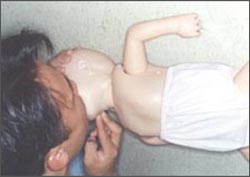
▴ 사진 1-195. ⑩
처치자의 입을 1세 이하의 영아나 작은 유아의 입과 콧구멍에 함께 대고 공기를 기도 속에 불어넣는다. 1세 이상 되는 환아를 위해서 처치자의 입으로 환아의 입에 대고 인공호흡을 할 때는 환아의 코 날개를 두 손가락으로 눌러 콧구멍을 손가락으로 막고 처치자의 입을 환아의 입에 대고 인공호흡을 한다. Copyright ⓒ 2011 John Sangwon Lee, MD., FAAP
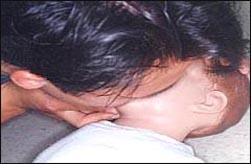
▴ 사진 1-196. ⑪
1세 이상 큰 유아에게 기본 심폐 소생술을 할 때는 처치자의 입을 환아의 입에 대고 공기를 기도 속에 불어넣는다. 이때 한 손으로 환아의 비익을 잡아 콧구멍을 막는다. Copyright ⓒ 2011 John Sangwon Lee, MD., FAAP
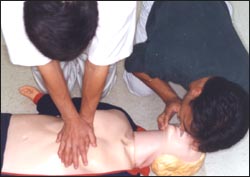
▴ 사진 1-197. ⑫
한 처치자는 처치자의 입을 환아의 입에만 대든지 또는 입과 콧구멍 두부위에 동시에 대고 공기를 환아의 기도 속에 불어넣고 다른 처치자는 심장 마사지를 해서 기본 심폐 소생술을 한다.Copyright ⓒ 2011 John Sangwon Lee, MD., FAAP
처치자의 입으로 하는 기본 인공호흡
-
구조자(처치자)가 환아의 입이나 콧구멍 근처에 귀를 바짝 갖다 대고 환아가 숨을 쉬고 있는지,
-
앞가슴이나 복부가 숨 쉬는 대로 올라갔다 내려갔다 움직이는지 관찰하든지,
-
환아의 앞가슴 위에 처치자의 손을 올려놓고 숨 쉬는지
-
또는 숨을 쉬지 않는지 알아본다.
-
환아가 숨을 거의 쉬지 못하거나,
-
전혀 숨을 쉬지 않는다고 판단했을 때는 다음과 같이 기본 심폐 소생술을 즉시 시작한다.
-
우선 처치자가 환아의 기도 속으로 불어 넣는 공기가 콧구멍 속과 입–인두강, 또는 입–구강, 인두강, 후두, 기관, 기관지 속을 통과해 폐 속으로 들어갈 수 있도록 기도를 열어준다. 이런 처치를 기도 확보라고 한다.
-
처치자의 한쪽 손을 환아의 이마 위에 올려놓고 머리를 뒤로 살짝 젖히고 다른 쪽 손을 그 환아의 턱 밑에 대고 턱을 살짝 위로 추켜올려서 인두 강 속이 더 크게 열리게 하고 구강– 후두– 기관–기관지 등의 기도 속이 더 활짝 열리도록 한다.
-
이때 혓바닥과 혀뿌리가 인두 강 속 뒤로 당겨 들어가 인두 강 부분의 기도 속이 막히지 않도록 주의한다.
-
가능한 한 인공호흡을 하는 동안, 머리, 얼굴, 목을 이런 위치 상태로 계속 유지시킨다.
-
그렇지만 목뼈가 손상됐거나, 손상됐다고 의심될 때는 목을 함부로 움직여서는 절대로 안 된다.
-
환아의 크기와 나이에 따라, 처치자의 입을 환아의 입에만, 또는 입과 콧구멍 두 부위에 대고 인공호흡을 해야 한다.
-
병원에서 진보 심폐 소생술을 받을 때까지, 또는 기본 심폐 소생술을 더 이상 할 필요가 없다고 판단이 날 때까지 계속 기본 심폐 소생술을 한다.
-
-
신생아나 영아와 같이 작은 아이에게 기본 심폐 소생술을 할 때는 신생아나 영아의 입과 콧구멍 두 부분에 처치자의 입을 대고 공기를 불어넣는다.
-
인공호흡을 해 주는 처치자 자신은 인공호흡 처치를 받고 환아의 나이와 크기에 따라 적당량의 공기를 흡입한 후 처치자는 입을 크게 벌리고 신생아나 영아의 입과 콧구멍 두 부위를 통과해 공기를 기도 속으로 불어넣어야 한다.
-
돌 이후 유아나 학령기 아이에게 인공호흡을 할 때는 환아의 양쪽 콧방울을 처치자의 두 손가락으로 꼭 쥐어 콧구멍을 막고 처치자의 입을 환아의 입에다 꼭 대고 환아의 입을 통과해 공기를 구강–인두강–하 기도 속으로 불어넣는다.
-
보통 때 숨 쉴 때처럼 환아의 앞가슴이 올라갔다 내려갔다 하도록 처치자는 적당량의 공기를 흡입한 후 공기를 환아의 기도 속으로 적절히 불어넣어야 한다.
-
그 다음 처치자의 입을 환아의 입에서 완전히 떼고 심장 마사지(심장 압박) 처치를 5번 연달아 한다.
-
처치자는 또다시 공기를 크게 들이마신 후 전과 같은 요령으로 한번 인공호흡을 하고 다음 심장 마사지를 5번 한다.
1분간 총 인공호흡 횟수는 환아의 나이와 크기에 따라 다르나
|
-
처치자의 입을 환아의 입에만, 또는 입과 콧구멍 두 부위에 대고 공기를 기도 속으로 불어넣은 후,
-
환아의 폐 속에서 공기가 저절로 흘러 입이나 콧구멍 밖으로 나오도록 처치자의 입을 환아의 입이나, 입과 콧구멍에서 완전히 뗀 다음 곧 바로 심장 마사지를 5번 연달아 한다.
-
인공호흡을 할 때 신생아나 영아의 입–구강 속과 콧구멍 속에 너무 세게 공기를 불어넣으면 폐포가 터질 수 있다.
-
숨을 거의 쉬지 못하거나, 아주 쉬지 못했던 환아가 스스로 숨을 거의 정상에 가깝게 또는 정상으로 쉴 때까지 기본 심폐 소생술을 계속 해야 한다.
-
기본 심폐 소생술을 효과적으로 하려면 한 사람 이상이 함께해야 한다.
-
기본 심폐 소생술 이외 더 필요한 치료와 처치를 해주어야 할 때가 많다.
-
그래서 기본 심폐 소생술을 시작하는 동시에 의료구급대, 응급실, 단골 소아청소년과 의사에게 긴급으로 전화해서 그들의 도움을 긴급히 청한다.
-
경우에 따라 구급차나 다른 적절한 교통수단으로 가장 가까이에 있는 종합 병원 응급실로 이송한다.
-
인공호흡을 해 줄 때는 심장 마사지도 동시에 해야 하는 것이 일반적이다.
-
인공호흡을 시작할 때, 하는 중 환아의 콧구멍이나 입을 통과해서 하기도 속으로 공기를 적절히 불어넣어도 공기가 하 기도 속으로 더 이상 들어가지 않거나, 보통 때 숨 쉴 때처럼 앞가슴이 올라갔다 내려갔다 하지 않으면 하 기도 속에 이물이 있든지 이물로 기도가 막히거나 구토 물 등으로 기도가 막혔을 가능성이 있다고 판단할 수 있다.
-
이런 경우, 하고 있던 인공호흡과 심장 마사지를 즉시 중지하고 입안이나 인두 강 또는 기도 내에 이물이 있나 체크해 본다.
-
입안이나 인두 강 등에 이물이 보이지 않고 숨을 계속 쉬지 않으면 인공호흡과 심장 마사지를 또 다시 시작하든지,
-
또는 그 환아의 양쪽 견갑골 사이 중간 부분을 처치자의 손바닥으로 5번 세게 쳐서 기도 속 이물이나 기도 속 구토 물이 입안으로나 입 밖으로 나오도록 빨리 시도한다.
-
그리고 또다시 인공호흡과 심장마사지를 전과 같이 계속 진행한다.
-
그래도 기도 속 이물 등으로 처치자가 공기를 환아의 입이나 콧구멍 속을 통해 기도 속으로 불어넣을 수 없고 환아가 숨을 쉬지 못할 때는
-
기도 내 이물 제거 앞가슴 밀기 처치법이나
-
기도 내 이물 제거 오목가슴 밀기 처치법으로 기도 속의 이물이 입 밖으로 나오게 또다시 시도한다.
-
그리고 인공호흡과 심장 마사지를 다시 시작한다.
-
1세 이전 영아의 경우, 기도 내 이믈 제거 등 치기 처치법과
-
기도 내 이믈 제거 가슴 밀기 처치법으로 기도 내 이물을 입안이나 입 밖으로 나오게 하고
-
1세 이후 유아들의 경우, 기도 내 이믈 제거 오목 가슴 밀기 처치법으로 기도 내 이물이 입안이나 입 밖으로 나오게 처치하는 것이 보통이다(기도 속에 이물이 들어갔을 때 참조).
-
Cardiopulmonary resuscitation for infants, toddlers, preschool children, school children or adolescents in the photos 사진으로 본 영아, 타들러아, 학령기전유아,학령기아, 사춘기아 기본 심폐 소생술 처치법

▴ Photo 1-186.
① Place the patient’s ear close to the child’s mouth or nostril and listen to the patient’s breath to see if the child is breathing. Copyright ⓒ 2011 John Sangwon Lee, MD., FAAP

▴ Photo 1-187. ② Either observe whether the forearm or abdomen moves up and down as you breathe, or see if the patient is breathing with the caregiver’s hand resting on the patient’s fore chest. Copyright ⓒ 2011 John Sangwon Lee, MD., FAAP

▴ Photo 1-188. ③ Check the pulse in the carotid artery If you are 1 year old or younger, check for pulses in the brachial artery in front of the elbow of infants (refer to ④) or the femoral artery in the groin (refer to ⑤) in front of the hip joint, or the carotid artery pulse in the neck of a patient older than 1 year. It is common to find out if your heart is beating. Or you can check if your heart is beating in your chest. It shouldn’t take longer than 1-2 seconds to find out if your heart is beating like this. Learn to track your pulse on a regular basis. Copyright ⓒ 2011 John Sangwon Lee, MD., FAAP

▴ Photo 1-189. ④ The pulse is measured in the left brachial artery. In 1 to 2 seconds, find out if the pulse is beating in the neck or in the front of the elbow or in the groin, or if the heart is beating in the chest. Copyright ⓒ 2011 John Sangwon Lee, MD., FAAP

▴ Photo 1-190. ⑤ Pulse in the femoral artery In a second or two, find out if a pulse is beating in the neck, arm, or groin, or a heart beating in the chest. Copyright ⓒ 2011 John Sangwon Lee, MD., FAAP

▴ Photo 1-191. ⑥ Again, find out if your heart is beating or breathing in your chest. Or check whether the pulse is beating or not in the neck, arm, or groin. Copyright ⓒ 2011 John Sangwon Lee, MD., FAAP

▴ Photo 1-192.
⑦ Open the airway to secure the airway so that it can be ventilated and breathe well. Place the patient’s hand on the patient’s forehead, tilt the child’s head slightly back, tilt the face and head slightly to the side, and then lift the chin and face slightly with the other hand.
Copyright ⓒ 2011 John Sangwon Lee, MD., FAAP

▴ Photo 1-193. ⑧ Tilt the child’s neck slightly back. The purpose of this treatment is to ensure that air enters and exits the airways well when performing artificial respiration, as shown in the photo. Copyright ⓒ 2011 John Sangwon Lee, MD., FAAP

▴ Photo 1-194. ⑨ If there is a discharge in the mouth or in the nasal cavity, remove the discharge. It should take no more than 30 seconds for the treatment to do so. Next, air is blown into the patient’s mouth through the patient’s mouth or through the child’s mouth and nostrils into the airways. At first, while blowing air into the airway #2, observe whether the forearm rises as usual when breathing. If the airways are completely blocked, air cannot pass through the upper and lower airways and enter the lungs, so it is common for the prothorax to not rise upwards when air is blown in. Copyright ⓒ 2011 John Sangwon Lee, MD., FAAP

▴ Photo 1-195. ⑩ Put the doctor’s mouth together in the mouth and nostrils of an infant or small infant under the age of 1 and blow air into the airways. For a patient over 1 year old, when artificial respiration is performed by placing the patient’s mouth into the patient’s mouth, press the child’s nose wings with two fingers to close the nostrils with fingers, and place the patient’s mouth against the child’s mouth for artificial respiration. Copyright ⓒ 2011 John Sangwon Lee, MD., FAAP

▴ Photo 1-196. ⑪ When performing basic CPR on older infants over the age of 1, place the patient’s mouth in the patient’s mouth and blow air into the airway. At this time, hold the child’s nose with one hand and close the nostrils. Copyright ⓒ 2011 John Sangwon Lee, MD., FAAP

▴ Photo 1-197. ⑫ One therapist touches the patient’s mouth only on the child’s mouth or at the same time on the head of the child’s mouth and nostrils, and blows air into the child’s airways, and the other therapist performs basic cardiopulmonary resuscitation by performing a heart massage. .Copyright ⓒ 2011 John Sangwon Lee, MD., FAAP
Basic artificial respiration with the rescuer’s(caregiver’s) mouth
- The rescuer puts his ear close to the patient’s mouth or nostrils, and whether the patient is breathing, Whether you observe whether the forearm or abdomen moves up and down as you breathe,
- Place the caregiver’s hand on the patient’s chest and breathe Or find out if he is not breathing.
- The patient can hardly breathe, or If you decide that he is not breathing at all, begin basic CPR immediately as follows:
1. First, open the airway so that the air that the caregiver blows into the patient’s airways can pass through the nostrils, mouth-pharyngeal cavity, or mouth-oral cavity, pharyngeal cavity, larynx, trachea, and bronchi to enter the lungs.This treatment is called airway securing.
2. Place one hand of the person on the patient’s forehead, place the head slightly back, place the other hand under the child’s chin, and lift the chin slightly upward to open the pharyngeal cavity to a greater extent, and the airways such as the oral cavity, larynx, trachea, etc. Try to open it wider.
3. At this time, be careful not to get the tongue and root of the tongue pulled back into the pharyngeal cavity and block the airways in the pharyngeal cavity.
4. As much as possible, keep the head, face, and neck in this position while performing artificial respiration.
5. However, when the neck bone is damaged or suspected of being damaged, the neck must not be moved carelessly.
6. Depending on the size and age of the patient, artificial respiration should be performed by placing the person’s mouth only in the patient’s mouth, or in both the mouth and nostrils.
7. Continue basic cardiopulmonary resuscitation until you receive advanced cardiopulmonary resuscitation
at the hospital, or until it is determined that basic cardiopulmonary resuscitation is no longer necessary.
- When performing basic CPR on a small child, such as a newborn or infant, air is blown through the mouth and the nostrils of the newborn or infant.
- The person who provides artificial respiration must receive artificial respiration and inhale an appropriate amount of air according to the patient’s age and size, and then the patient opens his mouth wide and passes the air through both the mouth and nostrils of the newborn or infant.
- Must be blown. When artificial respiration is given to infants or school-aged children after childbirth, close the nostrils by gripping both noses of the patient with the two fingers of the patient, and place the patient’s mouth tightly against the patient’s mouth and pass air through the child’s mouth to the oral-pharyngeal cavity. Blow into the prayer.
- As usual when breathing, the therapist should inhale an appropriate amount of air so that the patient’s chest goes up and down, and then properly inject the air into the patient’s airways. Then, remove the patient’s mouth completely from the patient’s mouth and perform cardiac massage (heart compression) 5 times in a row.
- After inhaling the air again, the therapist performs artificial respiration once again in the same way as before, and then performs cardiac massage 5 times.
The total number of ventilations per minute depends on the child’s age and size.
- After one artificial respiration, do cardiac massage (cardiac compression) 5 times.
- For infants before the age of 1, perform artificial respiration 20 times per minute. For infants after childbirth or school-age patients after infancy, perform artificial respiration 15 times per minute. For school-age children or adults after the age of 8, perform artificial respiration 10 to 12 times per minute.
- Place the patient’s mouth on the patient’s mouth only, or both the mouth and nostrils, and blow air into the airways,
- Immediately after removing the patient’s mouth from the patient’s mouth, mouth, and nostrils, perform a heart massage five times in a row so that air flows from the patient’s lungs by itself and comes out of the mouth or nostrils.
- During artificial respiration, the alveoli may burst if the air is blown too hard into the mouth-mouth and nostrils of a newborn or infant.
- Basic CPR should be continued until the child who can barely breathe or has not been able to breathe very close to normal on his or her own breaths. To be effective in basic CPR, more than one person must be present.
- In addition to basic cardiopulmonary resuscitation, it is often necessary to provide more necessary treatments and treatments. So, at the same time as starting basic CPR, call the medical paramedics, emergency room, and regular pediatricians urgently for their help.
- In some cases, an ambulance or other suitable means of transportation will be taken to the nearest hospital emergency room. When giving artificial respiration, it is common to do heart massage at the same time. When starting artificial respiration, even if air is properly blown into the lower respiratory tract through the child’s nostrils or mouth while performing artificial respiration, the air will no longer enter the lower respiratory tract, or if the forearm does not go up and down as usual when breathing.
Whether there is a foreign body in the lower airway, it can be judged that there is a possibility that the airway is blocked by a foreign body or by vomiting.
- In this case, immediately stop artificial respiration and heart massage and check for foreign objects in the mouth, pharyngeal cavity, or airways. If there is no foreign body in the mouth or pharyngeal cavity and you do not continue to breathe, re-start artificial respiration and heart massage,
• Still, if the patient is unable to blow air into the airways through the child’s mouth or nostrils and the
patient cannot breathe with a foreign object in the airway o How to remove foreign objects in the airways
and push the chest o
- Remove foreign objects in the airway
- Try again to get the foreign body out of the mouth with the epigastric push treatment method.
- Then restart ventilation and heart massage.
- In the case of infants before the age of 1, back
- stroke treatment such as removal of the airway
- Remove foreign substances in the airways
- Using the epigastric push treatment,
- make foreign objects in the airways come out of the mouth or out of the mouth.
- In the case of infants after 1 year of age, it is common to treat a foreign body in the airway so that the foreign body in the airway comes out of the mouth or out of the mouth with a concave chest push treatment (refer to when a foreign body enters the airway).
출처 및 참조문헌
Emergency Medical Service for Children, By Ross Lab. May 1989. p.10
Emergency care, Harvey grant and Robert Murray
Emergency Care Transportation of Sick and Injured American Academy of Orthopaedic Surgeons
Emergency Pediatrics A Guide to Ambulatory Care, Roger M. Barkin, Peter Rosen
Quick Reference To Pediatric Emergencies, Delmer J. Pascoe, M.D., Moses Grossman, M.D. with 26 contributors
Manual of Emergency Care 응급환자관리 정담미디어
소아가정간호백과-부모도 반의사가 되어야 한다, 이상원 저
The pregnancy Bible. By Joan stone, MD. Keith Eddleman, MD
Preparation for Birth. Berverly Savage and Dianna Smith
임신에서 신생아 돌보기까지. 이상원
Breastfeeding. by Ruth Lawrence and Robert Lawrence
Nelson Textbook of Pediatrics 14th ed. Beherman,
The Johns Hopkins Hospital, The Harriet Lane Handbook, 18th edition
Red book 29th-31st Ed 2021
Nelson Text Book of Pediatrics 19th-21st Edition
Infectious disease of children, Saul Krugman, Samuel L Katz, Ann A. Gershon, Catherine Wilfert
The Harriet Lane Handbook 19th Edition
Growth and Development of Children, George H. Lowrey 8th edition
소아과학 대한교과서
제1권 소아청소년 응급의료 참조문헌과 출처
Other
Copyright ⓒ 2015 John Sangwon Lee, MD., FAAP
“부모도 반의사가 되어야 한다”-내용은 여러분들의 의사로부터 얻은 정보와 진료를 대신할 수 없습니다.
“The information contained in this publication should not be used as a substitute for the medical care and advice of your doctor. There may be variations in treatment that your doctor may recommend based on individual facts and circumstances. “Parental education is the best medicine.”